Bodenverflüssigung
Locker gelagerte Böden neigen während einer Scherbelastung zu einer Verkleinerung des Bodenvolumens. Kommt hinzu, dass dieses Bodenvolumen wassergesättigt ist, d.h. der Porenraum mit Wasser gefüllt ist, muss das Wasser während einer Belastung aus dem Bodenvolumen austreten, damit sich das Bodenvolumen verkleinern kann. Ist die Belastung jedoch so schnell, dass das Wasser in dieser Zeit nicht entweichen kann bzw. wird das Ausfließen verhindert, entsteht ein Druck im Porenwasser. Dieser führt dazu, dass die Körner auseinander gedrückt werden und sich damit die Kontaktflächen zwischen den Bodenkörnern und auch die Kornkontaktkräfte verkleinern. Wird der Druck im Porenwasser immer größer, geht der Kontakt zwischen den Bodenkörner verloren und der Boden verhält sich wie ein Fluid – er verflüssigt.

Entstehung von Porenwasserdruck
Eine solche Bodenverflüssigung kann bspw. während eines Erdbebens in Erscheinung treten. Besteht der Boden aus einem grobkörnigen Material, aus welchem Wasser schnell entweichen kann, lässt sich eine Verflüssigung verhindern. Am Institut für Geotechnik wurde z.B. der Einsatz von Schottersäulen als Maßnahme zur Verhinderung von Bodenverflüssigung untersucht.
Das Mechanismus der Bodenverflüssigung lässt sich mit Hilfe eines Modellversuches, bestehend aus einer wassergesättigten Sandsäule, veranschaulichen. Das Grundprinzip für diesen Versuch liegt in der Einleitung eines dynamischen Impulses in das Sandvolumen, welches in einem Behälter eingeschlossen ist.
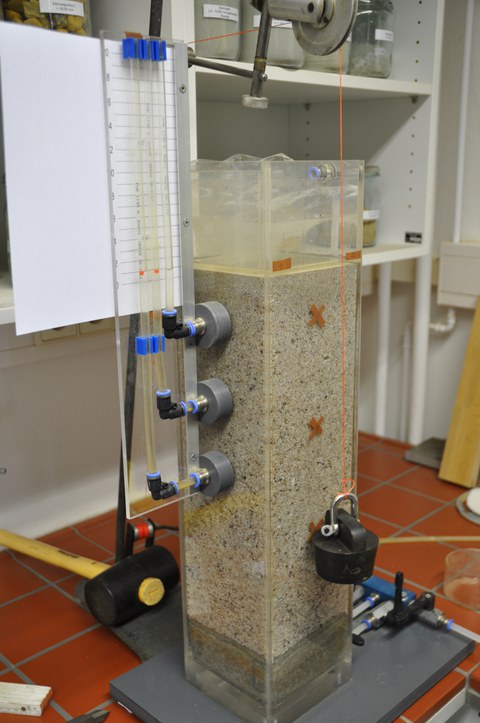
Versuchsstand zur Bodenverflüssigung
Zu Versuchsbeginn wird der Sand im trockenen Zustand in einen Plexiglasbehälter eingerieselt und anschließend von unten nach oben mit Wasser durchströmt. Auf diese Weise wird eine lockere Lagerung und eine hohe Wassersättigung des Sandes erzeugt. Bei lockerer Lagerung und hohem Sättigungsgrad führt die dynamische Anregung zu einem Schwingen des Behälters und somit zur zyklischen Scherbeanspruchung. Diese ruft eine Verdichtung des Sandes hervor. Wenn die Impulseintragung sehr schnell stattfindet, so dass ein Ausströmen des Porenwassers in dieser Zeit kaum möglich ist, können kurzfristig undränierte (volumentreue) Bedingungen angenommen werden. Dabei entstehen Porenwasserdrücke, welche die Korn-zu-Korn-Spannungen verkleinern. Werden die Korn-zu-Korn-Spannungen sehr klein, geht die Steifigkeit des Bodens gegen Null und der Boden verhält sich wie eine Flüssigkeit. Dabei entstehen große Oberflächensetzungen.
Die beim Modellversuch entstandenen Porenwasserdrücke, in verschiedenen Höhen des Versuchsbehälters, lassen sich über die Steighöhen von Wassersäulen bestimmen.
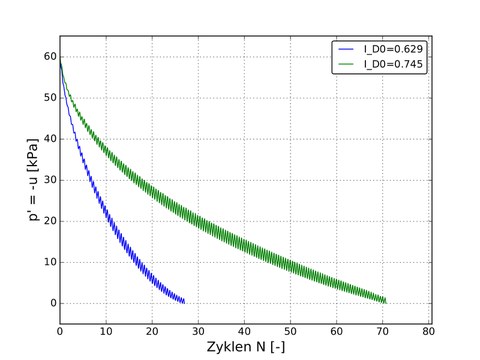
Entwicklung des Porenwasserdrucks in Abhängigkeit der zyklischen Belastung für einen Sand mit unterschiedlicher Lagerungsdichte
Die Bodenverflüssigung wird wesentlich von den granulometrischen Eigenschaften des Bodens beeinflusst. Die höchste Neigung zur Verflüssigung haben sandige Böden. Für diese Böden kann bei voller Wassersättigung eine Verdichtung nur durch das Ausdrücken des Porenwassers stattfinden. In Abhängigkeit von der Wasserdurchlässigkeit des Bodens können dabei Porenwasserüberdrücke entstehen, die die effektiven Spannungen bei gleich bleibenden totalen Spannungen verringern. Entsprechen die Porenwasserüberdrücke den effektiven Spannungen, zerfällt das Korngerüst und der Boden verhält sich wie eine Flüssigkeit.
Im Rahmen dieses Projekts wird die Verflüssigungsneigung verschiedenere grobkörniger Böden anhand eines eigen entwickelten Identifikationsversuches beurteilt.
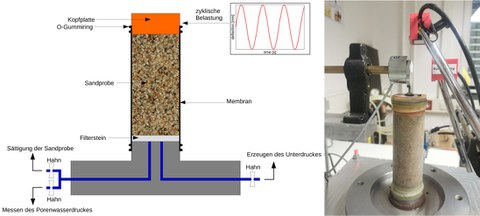
Prinzipskizze und Bild des Versuchsaufbaus
Dazu wird auch ein numerisches Modell mit einem fortgeschrittenen hypoplastischen Stoffmodell erstellt.
Erdbeben verursachen enorme wirtschaftliche und humanitäre Schäden, insbesondere wenn die Erdbeben eine Bodenverflüssigung hervorrufen. Als Bodenverflüssigung wird in der Regel das Verschwinden der effektiven Spannungen infolge des Aufbaus von Porenwasserdrücken bezeichnet. Dies wird durch einen Verlust der Bodensteifigkeit und -scherfestigkeit manifestiert. Sandaufbrüche, Setzungsunterschiede, Fließrutschungen und ein Verlust der Tragfähigkeit bei Bauwerken können die Folge sein.
Am Institut für Geotechnik der TU Dresden wurden Zentrifugenversuche an einem gefluteten Erddamm numerisch nachgerechnet. Hierfür wurde ein fortgeschrittenes hypoplastisches Stoffmodell verwendet. Ziel war es einerseits das Dammverhalten bei Erdbebeneinwirkung zu analysieren und andererseits die Verlässlichkeit des verwendeten Stoffmodelles bei der Anwendung für dynamische Randwertprobleme zu überprüfen. Es konnte gezeigt werden, dass die berechneten und gemessenen Verschiebungen sehr gut übereinstimmen. Sowohl beim Zeitverlauf der Setzungen während des Erdbebens als auch bei den Endsetzungen lagen die berechneten und gemessenen Werte sehr nah beieinander. Unterschiede gab es jedoch bei den gemessenen und berechneten Porenwasserdruckverläufen in böschungsnähe.

Berechnete und gemessene Verschiebungen in einem geflutete Damm unter Erdbebeneinwirkung
Die guten Übereinstimmungen basieren auf einer aufwendigen Kalibrierung der Stoffmodellparameter. Für diese wurden zyklische undränierte Triaxialversuche nachgerechnet und sowohl die Abnahme des Schubmoduls mit zunehmender Scherdehnung als auch die Abnahme der effektiven mittleren Spannung mit der Zyklenzahl ausgewertet.
Die Anwendung von Schottersäulen zur Verhinderung von Bodenverflüssigung hat in den letzten Jahren zugenommen. Untersuchungen zu deren Funktionsweise sind jedoch kaum vorhanden. Dies lässt sich damit begründen, dass sowohl numerische Berechnungen mit einfachen Stoffmodellen als auch kleinmaßstäbliche Laborversuche problematisch sind.
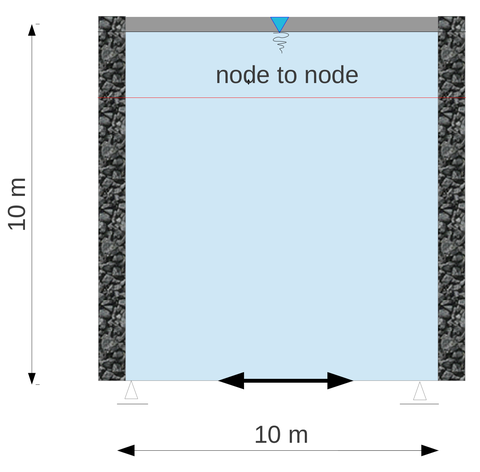
Numerisches Modell zur Untersuchung des Verflüssigungsverhaltens von Böden mit Schottersäulen
Am Institut für Geotechnik der TU Dresden wird die Anwendung von Bodenverbesserungssäulen als Prävention zur Bodenverflüssigung numerisch untersucht. Hierfür wurde ein fortgeschrittenes hypoplastisches Stoffmodell verwendet. Das Augenmerk der Untersuchung liegt dabei auf dem Einfluss von Steifigkeit und Durchlässigkeit der Säulen. Weiterhin wird der Einfluss der Säulenherstellung auf den umliegenden Boden untersucht. Zur Validierung der numerischen Berechnungen wurden Zentrifugenversuche durchgeführt und numerisch nachgerechnet. Die Berechnungen zeigen, dass die Bodenverbesserungssäulen sowohl durch ihre hohe Steifigkeit als auch durch ihre hohe Durchlässigkeit die Verflüssigung verhindern können.
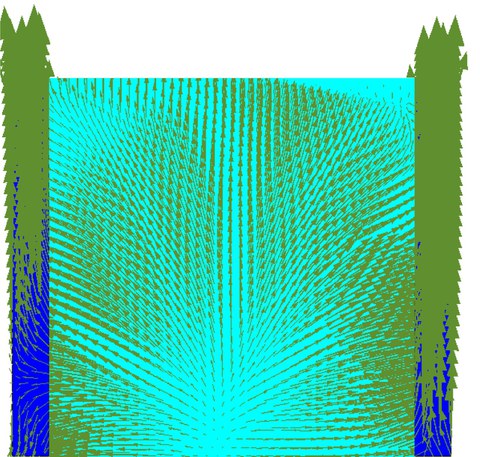
Strömungsrichtungen des Porenwassers während eines Erdbebens in einem Boden mit Schottersäulen
